People generally get excited when they hear I get Botox for migraine and ask a lot of questions. After all, it does make my forehead look smooth. However, the excitement usually wears off after I explain that I first had to trial and fail a multitude of preventive medications, that I’ve had daily migraine attacks for years before I started the Botox treatment, and that despite my Botox treatment I still have migraine disease and experience some attacks. Sadly, there is no cure for migraine. Nevertheless, everyone wants to know about this topic: botox for migraine- what to expect.
However, for those of us living with migraine, Botox is something to be excited about. It is an approved and effective preventive treatment for migraine which can help us manage our migraine disease and improve our quality of life. It has definitely done that for me.
While Migraine Strong writes about the latest in migraine treatments, this is not medical advice. We are patient educators and all information you read should be discussed with your doctor.
What Is Botox?
OnabotulinumtoxinA (Botox) is an FDA-approved cosmetic treatment which temporarily improves frown lines, crow’s feet, and forehead lines in adults. In fact, people who were getting Botox for purely cosmetic reasons discovered that their headaches improved! That is when Botox’s effect on migraine was discovered. Finally, in 2010, the U.S. Food and Drug Administration (FDA) approved onabotulinumtoxinA (Botox) as a preventive treatment for chronic migraine. At this time, Botox is not approved for episodic migraine because studies determined it is not effective.
The precise mechanism of Botox for migraine is still unknown. However, it is effective and generally well tolerated for the prevention of chronic migraine. On average Botox prevents 8 to 9 headache days and migraine days a month. It has been shown that Botox is effective in the frequency, severity and reduction of headache days. It is an especially useful treatment for patients who previously did not respond to treatments or experienced side effects from commonly prescribed preventive oral medications.
How To Get Approved For Botox For Migraine
The first step to get approved for Botox for migraine is to consult your headache specialist or neurologist. They will let you know if you qualify and help you to start the process.
Generally, to qualify for Botox for migraine, you must have a chronic migraine diagnosis. Chronic migraine is when a patient experiences 15 or more headache days each month, for more than 3 months, with migraine on at least 8 of those days.
For insurance approval, it is also necessary to try several preventive medications which either did not work for you or caused intolerable side effects.
What To Expect With Botox For Migraine
Botox involves regular injections administered every three months into approximately 31 proven injection sites, divided across 7 specific head and neck muscle areas. (See photographs below.) It is a preventive treatment, meaning it is meant to stop migraine attacks before they even begin.
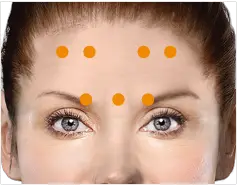
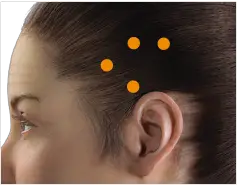
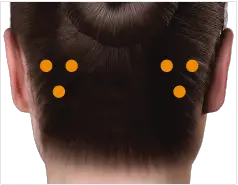
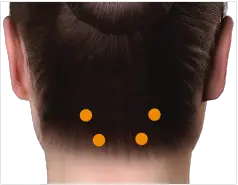
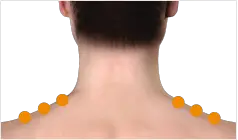
We see many members in our Migraine Strong Facebook group post comments about feeling nervous about their upcoming Botox injections. I hope this article helps to alleviate those fears.
The Procedure
Botox injections normally take place at your doctor’s office. The procedure takes anywhere from 5-15 minutes and you can expect to go home right after. Most people can safely drive home.
My headache specialist is located about an hour away from my home. I typically sit comfortably in a chair while my doctor administers the injections. My doctor chats with me the entire time and it usually takes no more than 5 minutes. The injections are administered with a very fine needle that feels like tiny pinches. Although we all experience sensations and pain differently, Botox injections are typically only uncomfortable and are generally not very painful.
Some people have a fear of needles. If needles are a fear for you, consider talking with your physician about a plan to reduce your needle anxiety like a prescription for low dose Valium or Xanax to take before the procedure. You will need someone to drive you home if you do decide to take that medication.
After your physician administers Botox injections, you may have tiny spots of blood at the injection sites. My doctor wipes them off with a gauze, hands me an ice pack for my face, which I usually decline, and I am ready to go home. I usually feel sleepy for the rest of the day so when I get home I make sure to rest. There is usually some soreness at the injections sites in my head and neck for a few days. I prefer to use heat to alleviate the soreness and rely on the Huggaroo neck wrap and Huggaroo headache hat. If you prefer cold, I would recommend using the Koldtec Halo.
When Does Botox Help Migraine
There is evidence that Botox works over time. Patients who received three cycles of Botox for migraine, showed that their headache symptoms, acute medication usage, headache impact and health-related quality of life continued to improve with treatment. [1]
According to Allergan, the manufacturer of Botox, patients with migraine must begin with two treatments, 12 weeks apart. Then treatments should continue every 12 weeks. Patients may see some results as soon as 4 weeks after beginning treatment and then headache day reduction will gradually improve over the next 24 weeks. [2]
As mentioned above, there is research that Botox for migraine works over time. Around 1/4 of the patients who did not achieve a clinically meaningful (i.e. ≥ 50%) reduction in headache symptoms after the first treatment cycle did respond after the second cycle. While approximately 1/3 of the patients who did not achieve a clinically meaningful reduction in headache impact (how it impacts your life) after the first treatment cycle did respond after the second cycle. Moreover, around 1/4 of the patients who did not respond in terms of these parameters after the first and second cycles did respond after the third cycle. This suggests, therefore, that at least 2 to 3 cycles of Botox for migraine should be attempted before stopping treatment. [3]
Personally, I did not experience improvement until my second treatment. Because of this I always thought that I “failed” my first treatment. In fact, I often see members in the migraine community discussing this common occurrence. However, not getting results until subsequent treatments is actually quite normal.
How To Predict If Botox For Migraine Is Going To Help
In some patients, Botox dramatically reduces the frequency of migraine attacks, while it has no effect for others. Approximately 65% of patients with chronic migraine respond to onabotulinumtoxin A (Botox) after 3 courses of treatment. [4]
Dr. Rami Burstein conducted a study published in 2006 which searched for a neurological marker that differentiated between migraine patients who respond to Botox treatment and those who do not benefit from it.
Different types of pain
Dr. Burstein found that some patients perceive their pain as pressure buildup inside their head (exploding headache) while others perceive their pain to be inflicted from the outside in (imploding headache).
Among those who did not respond to Botox, 92% described a buildup of pressure inside their head (exploding headache).
Among those patients who responded to Botox, 74% perceived their head to be crushed, clamped or stubbed by external forces (imploding headache). [5]
According to Dr. Mauskop in his 2009 New York Headache blog, many more patients suffer from “imploding” headaches or headaches with pain in the eye than with “exploding” headaches.
Botox For Migraine Side Effects
This procedure is significant and expensive. Before you commit to it, it’s important to know about some of the possible side effects to expect from Botox.
Back in 2000, when I was a freshman at Syracuse University I went back home to Connecticut to get my Botox injections. This was before Botox was approved for chronic migraine. At that time, I was receiving Botox for chronic neck pain and migraine. My regular doctor was not available so I was scheduled to see someone else.
Unfortunately, this other doctor was not experienced in administering Botox and injected too much medication into my neck. As a result, I suffered from muscle weakness in my neck and had difficulty holding my head up until the Botox wore off three months later. Have you ever tried brushing your teeth while you cannot keep your head up? Or taking notes in class while listening to a lecture? While a freshman at college? Neck muscles are certainly one of those things we take for granted until they are gone. Botox for migraine side effects should be understood especially when the shots are given by a person without vast experience.
My story is not meant to scare you. Botox for migraine is now an FDA approved treatment with a protocol for injection sites and specific doses for medication administration. However, I cannot stress enough the importance of seeing a trained healthcare professional with experience using Botox for migraine in order to reduce your risk of side effects or complications.
Who Should Administer Botox For Migraine
According to Allegran, a Botox specialist who has expertise in treating chronic migraine by injecting Botox into proven sites around the head and neck for the full beneficial effect should administer Botox. It can be your headache specialist or neurologist. Nurse practitioners can administer Botox for migraine as well.
Consider asking the healthcare professional how long they have been administering Botox and how many procedures they have done. Allergan provides a tool where you can search for a qualified Botox specialist by location. The Botox for migraine side effects should be less of a concern with an experienced specialist.
The Most Common Side Effects
Studies show that Botox for migraine treatment is well tolerated by patients. The most common Botox for migraine side effects include neck pain, headache, migraine, drooping eyebrows, eyelid drooping, muscular weakness, musculoskeletal stiffness, or muscle spasms. [6] [7]
Studies show that the side effects decrease progressively with each subsequent treatment session. [8] This is great news for those of you who have experienced some of these side effects after your Botox treatment. If your doctor recommends that you continue the treatment, there is a good chance the side effects will improve with subsequent treatment.
If the Botox for migraine side effects do not disappear, discuss your symptoms with your doctor who might recommend reducing the dose of Botox for the next treatment, avoiding Botox treatments or trying Myobloc (rimabotulinumtoxinB) instead.
Other Botulinum Toxin Products
There are two other botulinum toxin products on the market, but at this time only Botox is approved by the FDA for the treatment of chronic migraine. These other two products are Dysport (abobotulinumtoxinA) and Xeomin (incobotulinumtoxinA). They are more similar to Botox because they are also type A botulinum toxins. There is also Myobloc which is botulinum toxin type B.
In a 2008 study, Myobloc was found to be safe and effective in treating various headache syndromes. It is considered to be similar to Botox and an option for headache prophylaxis. [9]
At this time, only Botox is approved by the FDA for the treatment of chronic migraine headaches, while the other three are approved for movement disorders such as dystonia as well as for cosmetic use.
Discuss with your doctor the alternative types of botulinum toxins if you experience side effects from the Botox for migraine, or if the treatment stops working for you.
Does Botox For Migraine Help Patients With Vestibular Migraine
The efficacy of Botox for dizziness and vertigo has not been evaluated. Many vestibular migraine patients suffer from symptoms of dizziness and vertigo, some do not experience head pain.
According to a 2017 case report from Korea, a vestibular migraine patient was successfully treated with Botox. She was 58 year old with chronic migraine and recurrent dizziness for 10 years. Medication had not provided satisfactory pain relief and dizziness control. Her intractable head pain and dizziness disappeared 1 day after Botox injections. This case suggested that Botox is effective for dizziness or vertigo in vestibular migraine patients, in addition to being effective for head pain. [10] Further studies are needed to confirm the efficacy of Botox for dizziness and vertigo in migraine patients.
Dr. Alexander Mauskop noted in his 2017 Headache blog that when vestibular migraine patients have frequent headaches he offers them Botox injections, which are not appropriate if headaches are infrequent. [11]
Does Insurance Cover Botox For Migraine
If you are wondering how much Botox for migraine cost, it is expensive. However, most insurance companies in the United States approve some part of the treatment. To qualify for Botox for migraine you need the following:
- You must have a chronic migraine diagnosis, meaning you must have 15 or more headache days a month.
- Most insurance companies require that patients fail to respond to or experience side effects to at least 2 or 3 other preventive medications.
Allergan offers a Botox Savings Program which could help you with out-of-pocket costs not covered by insurance.
What If Migraine Symptoms Return Before 12 Weeks
For some people, Botox does not last the full 12 weeks, which is the standard treatment timeline. In general, insurance companies do not approve Botox sooner than 12 weeks. You have two options. (1) You can ask your doctor to write to the insurance company requesting approval that Botox be administered to you sooner. (2) You can speak to your doctor about doing nerve blocks and trigger point injections a few weeks before the next Botox treatment to provide you the necessary relief. My doctor does nerve blocks/trigger point injections 2 weeks before Botox and 2 weeks after Botox for some patients while they wait for the treatment to kick in.
Nerve blocks are procedures during which a mixture of a local anesthetic and a steroid are injected in the area around the nerves. Although an occipital nerve block is one of the most common procedures, continue to experiment with your neurologist/headache specialist until you find the combination of nerves/trigger points which provide the most relief for you.
What If Botox For Migraine Stops Working
In a very small number of patients, Botox loses its effectiveness over time. [12]
This happens either because (1) the person develops antibodies as a defense mechanism to block the effect of Botox or (2) migraine evolves and stops responding to Botox.
According to Dr. Alexander Mauskop, fewer than 1% of patients develop antibodies to Botox. However, patients who develop antibodies to Botox (type A toxin), may respond to a similar product, Myobloc, which is a type B toxin. Myobloc is not approved by the FDA to treat chronic migraine. However it has a similar mechanism and has been shown to relieve migraine in several studies.
Rebound Headaches and Botox
Rebound headaches or medication overuse headaches are caused by excessive use of acute (prescribed or over the counter) medications. Unfortunately they have a low response to prophylactic treatments meaning that preventive medications are not effective when a patient is experiencing rebound headaches. Essentially, to end the rebound headaches cycle, you must stop all pain relievers.
Botox for Migraine has been determined to be beneficial in patients who have rebound headaches. [13] There is some research which suggests to stop all medications first before initiation expensive Botox treatment. [14] Be your own advocate and ask for treatment which will increase your likelihood of success in ending your rebound cycle.
My chronic migraine journey began five years ago when I got pregnant and gave birth to my kids. I developed chronic migraine complicated by rebound headaches. Daily migraine attacks left me home-bound and hopeless. I ended my rebound cycle by taking prednisone for migraine, getting nerve blocks, Botox injections, and chiropractic treatment. My headache specialist helped me succeed in ending my rebound cycle by offering these options to me.
Botox And The Treatment Pie
For some people, Botox for Migraine is the answer they have been waiting for. It prevents all their migraine attacks and allows them to live nearly migraine free.
However, for most of us living with chronic migraine it is another effective preventive treatment which needs to be used in conjunction with the other slices of the Migraine Strong “Treatment Pie.” This essentially means that in addition to Botox treatment, you need to also make lifestyle changes, meditate, hydrate, take supplements, take other preventive medication(s), and/or exercise. Because each individual is differently affected by migraine, we all have to find our own combination of treatments which work for us.
For me, Botox is one of the treatments which helps me manage migraine disease. Other preventive medications, injectibles, nerve blocks, supplements, and meditations are some of the slices of my treatment pie.
Conclusion
If you haven’t found an effective preventive treatment for migraine, I hope this article provides you with enough information to help you know what to expect from Botox for migraine. You can discuss this with your provider to determine whether it is an option for you. Feel free to join our Migraine Strong Facebook group to chat with other members who get Botox to manage their migraine disease.
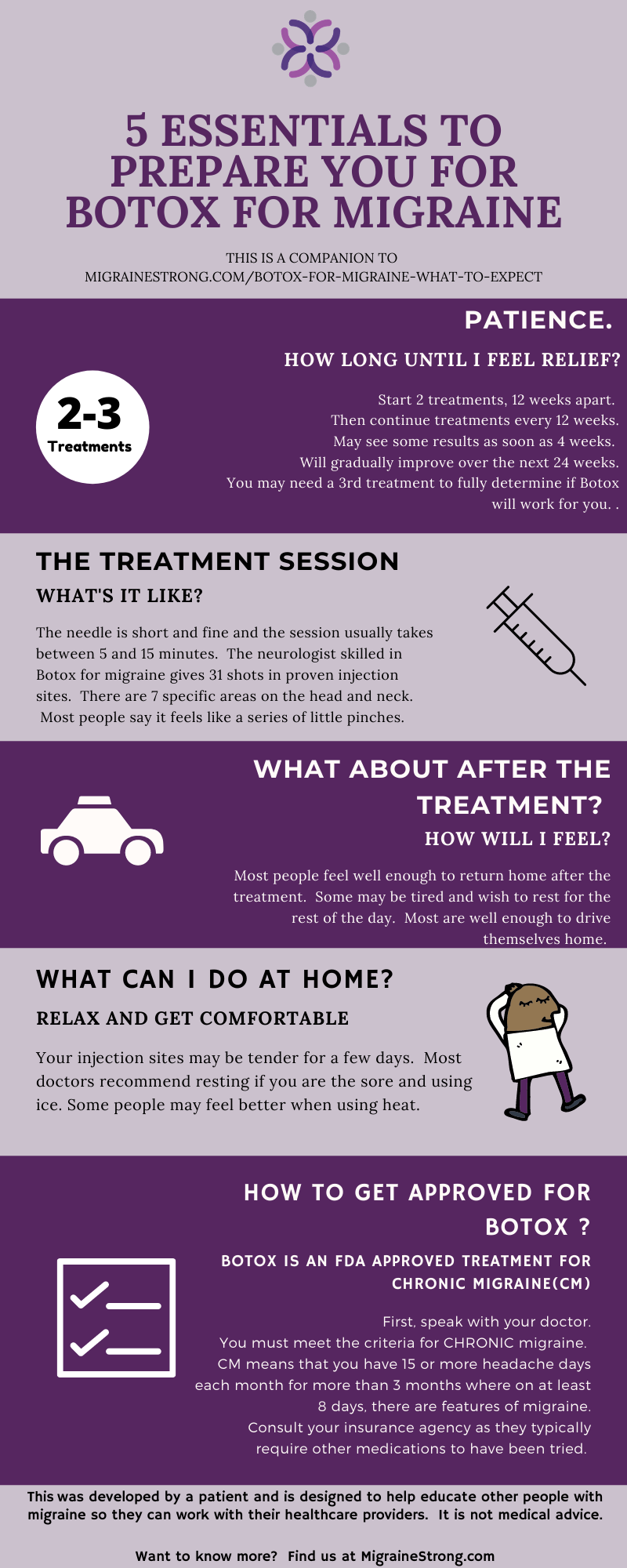
This article is not sponsored by Botox or Allergan. There are some affiliate links in this article, which means Migraine Strong will make a small fee at no cost to you, if you choose to buy through our links.
The information in this article is to help you educate yourself and is not medical advice. Please consult your healthcare provider before changing your migraine treatment.
References:
[1] OnabotulinumtoxinA: A Review in the Prevention of Chronic Migraine. 2018
[2] https://www.botoxchronicmigraine.com/chronic-migraine-treatment
[3] OnabotulinumtoxinA: A Review in the Prevention of Chronic Migraine. 2018
[4] The Journal of Headache and Pain. 2018.
[5] https://www.ncbi.nlm.nih.gov/pmc/articles/PMC1831831/
[6] https://www.botoxchronicmigraine.com/pdf/You_Got_This_Online_DDG_Headache_Specialist.pdf
[7] OnabotulinumtoxinA: A Review in the Prevention of Chronic Migraine. 2018
[8] OnabotulinumtoxinA: A Review in the Prevention of Chronic Migraine. 2018
[9] Onabotulinumtoxina therapy is also effective for dizziness in vestibular migraine
[10] https://www.sciencedirect.com/science/article/abs/pii/S0041010108002705?via%3Dihub
[11] Vestibular migraine
[12] What to do when Botox stops working
[13] OnabotulinumtoxinA: A Review in the Prevention of Chronic Migraine. 2018
[14] https://academic.oup.com/brain/article/142/5/1203/5457721

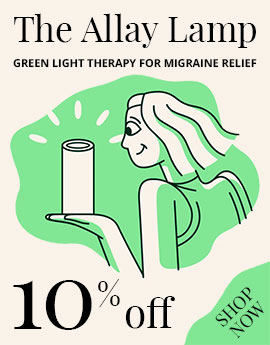
Awesome post! Thanks for sharing the knowledge and keep up the good work.
Thank you for your info as I was diagnosed at age 9 and am currently sitting at 39 and have yet to fully find a nice piece of my pie to help but it is a work in progress
It’s good to know that we’ll need lots of rest and ice or heat after the Botox treatment. My older sister is looking into getting Botox treatment for migraines within the next couple of months. I’ll share this info to help her develop the best plan for recovering after the treatment!
Good luck to her!! It has been helpful for me! -eileen
I am nearing my 3rd round of botox for migraine and am wondering if for anyone else it seems to make migraines better than baseline for the first 6 weeks and worse than baseline for the second 6 weeks? This is making me question whether or not to get the 3rd round.
I don’t recall hearing many people say that. I wish I had more specific feedback for you. That’s a good question for your doc. I hope you feel better soon. – Danielle
I have been prescribed Botox for my Vestibular Migraine…I’ve been “dizzy” for over a year…feeling like I’m on a rocking boat…taking magnesium, B2, Candesartan 16, ….no painful headaches (for the past year)….wondering if anyone has had success from Botox for Vestibular Migraine…? Thank you so much…Denise
I am booked in for 15th September and I have always been against botox, so I am still scared to go ahead with this treatment.
Can I drive home after the injections? I live probably 30 minutes drive from the hospital.
The side affects are my greatest worry, drooping eyes or eyelids is that permanent or how long is it temporarily?
I am having sheer fear anxiety just thinking of it.
Glad you are booked.It’s important to to keep trying interventions and being hopeful that tomorrow will be a better day. Many people drive themselves home but ask the doc’s office for their recommendations for you. Only SOME people have that side effect. Most do not. It is considered temporary and fades as the botox fades. This could make a BIG difference for you. Fingers crossed!
Just like with any other medical treatment, the outcome of Botox injections will vary from patient to patient. With that being said, current research suggests that Botox treatment for chronic migraines is successful at significantly reducing the frequency of headache episodes each month.